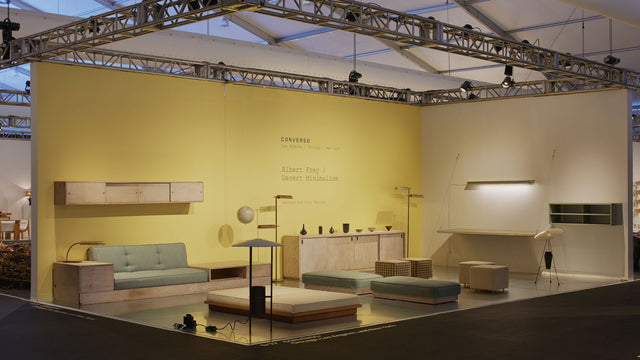Albert Frey
Desert Modernism Palm Springs
The suite of furniture, early designs with construction notes in Frey's own hand in his preferred material, whitewashed pine, includes a signature Globe lamp and Frey's own cable suspended desk, upon which many of his notable works were drafted. The collection is rounded out by wall and floor cabinets, floor cushions and a couch composition upholstered in Monk's Cloth in sage green, one of Frey's four signature colors from his own Palm Springs office. The entire suite, including a rolling platform bed, was repurposed by Frey for the home of Elise Wolfe, his lover through the 50's and 60's and lifelong intellectual companion.
Frey came to envision the arid landscapes of the Coachella Valley as a Utopian site in which to pursue his purist architectural ideals. He realized a small number of famous residences for figures like Raymond Loewy as well as Frey House I and II, his own super minimalist residences that disappear perfectly into the surrounding desert. Frey's iconic works, including several municipal projects, are now inextricably linked to the identity of California desert modernism.

About Albert Frey
Frey began his career in Corbusier's office working on the Villa Savoye and other important projects alongside Josep Lluis Sert, Maekawa, Perriand and Jenneret. He was the first architect from Corbusier's office to come to the U.S., where he formed an important partnership with A. Lawrence Kocher in New York, the influential editor of Architectural Record, which they used as a platform to promote progressive architecture in the U.S. Their Aluminaire House project (1931), the first low cost, all metal, prefabricated house, was featured in MoMA's famous exhibit, 'International Style, Architecture Since 1922', which served as the basis for Johnson and Hitchcock's famous manifesto, 'The International Style'.
In 1937, Frey was invited by Alfred Barr to contribute important design details to MoMA's permanent site, preserved in the recent Tanaguchi renovation. Frey and Kocher also contributed to the design of Black Mountain College. Increasingly drawn to the West Coast and the barren spaces of the Coachella Valley in the late 30's, Frey established his architectural practice in Palm Springs where he remained for the rest of his life. Through the well-known residences and municipal projects he built there, he laid the foundation for that community's identity as a modernist Mecca.

